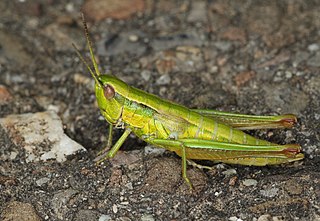
Salamandridae is a family of salamanders consisting of true salamanders and newts. Salamandrids are distinguished from other salamanders by the lack of rib or costal grooves along the sides of their bodies and by their rough skin. Their skin is very granular because of the number of poison glands. They also lack nasolabial grooves. Most species of Salamandridae have moveable eyelids but lack lacrimal glands.

Heptathela is a genus of spiders that includes the Kimura spider. They are trapdoor spiders of the family Heptathelidae and are found in Japan, including Okinawa and the Ryukyu Islands. Spiders of this genus lack venom glands.

Macrothele is a genus of mygalomorph spiders in the family Macrothelidae, and was first described by A. Ausserer in 1871. Most of the species in the genus occur in Asia, from India to Japan, and Java, with five found in Africa, and two in Europe. The name is derived from Ancient Greek μακρός ("makro-"), meaning "big", and θηλή ("thele"), referring to the spinnerets.

Gammarus is an amphipod crustacean genus in the family Gammaridae. It contains more than 200 described species, making it one of the most species-rich genera of crustaceans. Different species have different optimal conditions, particularly in terms of salinity, and different tolerances; Gammarus pulex, for instance, is a purely freshwater species, while Gammarus locusta is estuarine, only living where the salinity is greater than 25‰.

Gomphocerinae, sometimes called "slant-faced grasshoppers", are a subfamily of grasshoppers found on every continent but Antarctica and Australia.

Neoaliturus is a genus of leafhoppers in the tribe Opsiini and the subfamily Deltocephalinae. There are more than 30 described species in Neoaliturus.

The Pompilinae are a subfamily of the spider wasp family, Pompilidae, the species of which lay their eggs on the paralyzed bodies of their prey.

The Pepsinae are a subfamily of the spider wasp family, Pompilidae, including the two genera of large tarantula hawks, as well as many genera of smaller species.

Eucnemidae, or false click beetles, are a family of elateroid beetles based on the type genus Eucnemis; they include about 1700 species, distributed worldwide.

Cacopsylla is a genus of bugs known as jumping plant lice. It includes most of the subfamily Psyllinae harmful to fruit trees; for example, insects referred to by the common name "pear psyllids", can only develop on plants of the genus Pyrus.

Calophya is the type genus of the psyllid bug family Calophyidae.

Aphalara is a genus of jumping plant lice (psyllid) in the family Aphalaridae.

Psyllopsis is a genus of plant lice, now placed in the subfamily Euphyllurinae.

Pepsini is a tribe of spider wasps in the family Pompilidae.

Liviidae is a family of plant lice, with about 19 genera.
Paralimnini is a tribe of leafhoppers in the subfamily Deltocephalinae. Paralimnini contains 139 genera and over 900 species divided into two subtribes: Aglenina and Paralimnina. The tribe has a cosmopolitan distribution.

Psammotettix is a genus of true bugs belonging to the family Cicadellidae. The species of this genus are found in Eurasia and North America
Auritibicen is a genus of cicadas from East Asia and Russia. The genus was first described in 2015.

Livia is the type genus of plant lice in the family Liviidae, found in the Palaearctic and Nearctic realms. Nymphs form galls in the developing shoots of rushes and sedges.
















